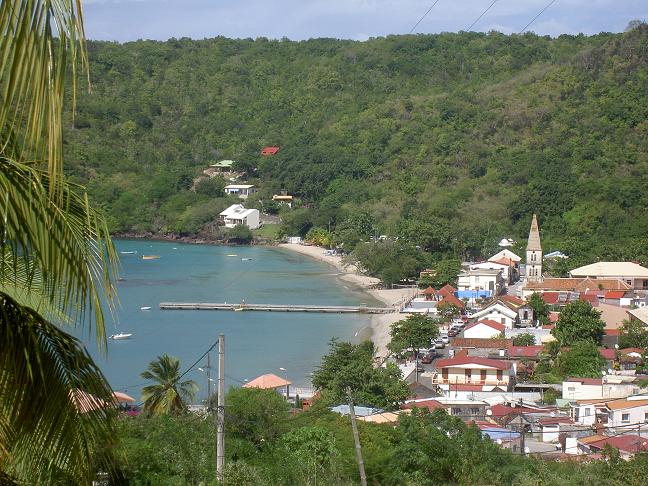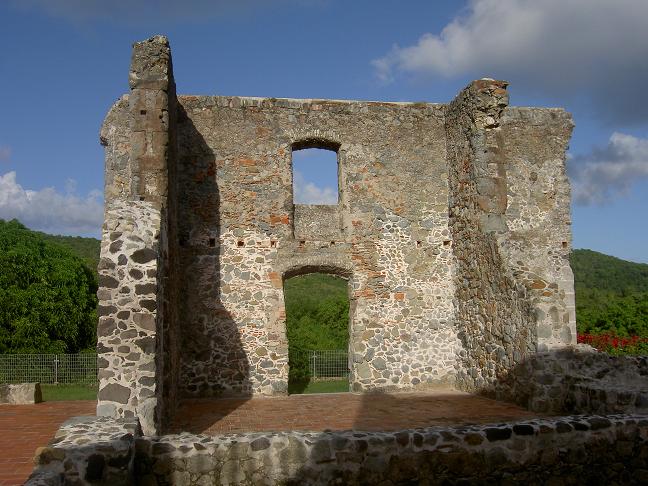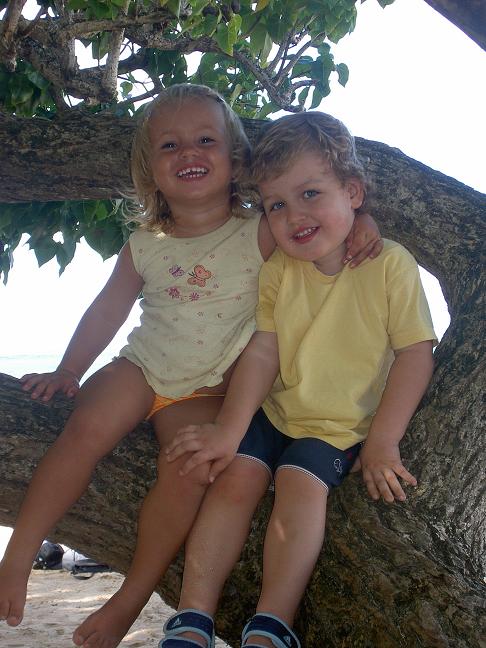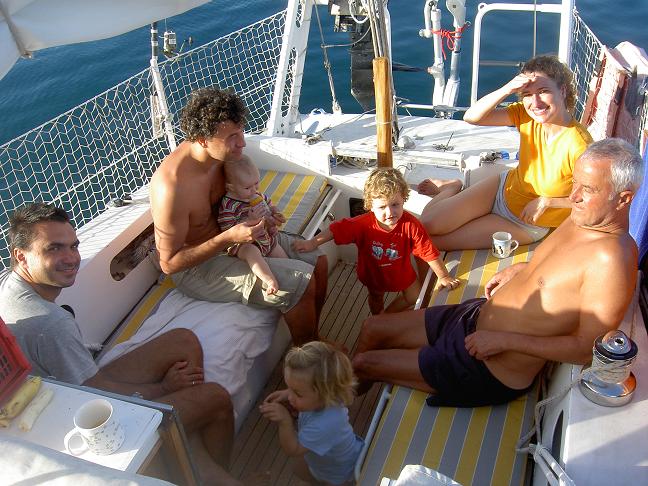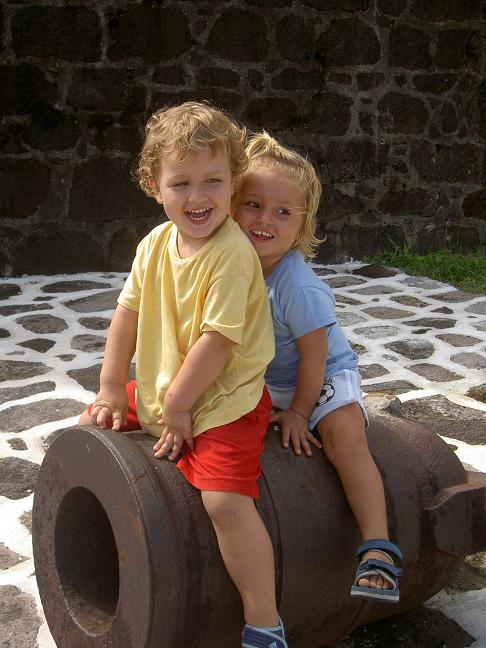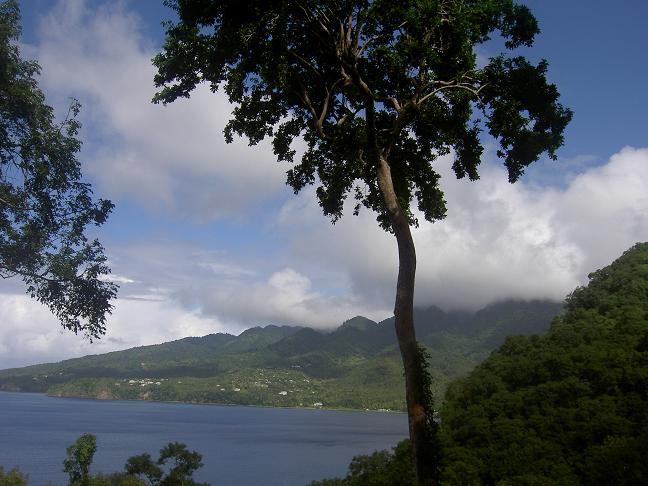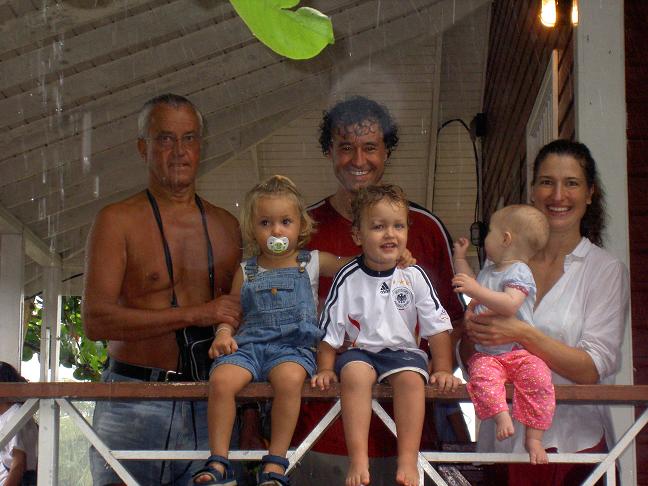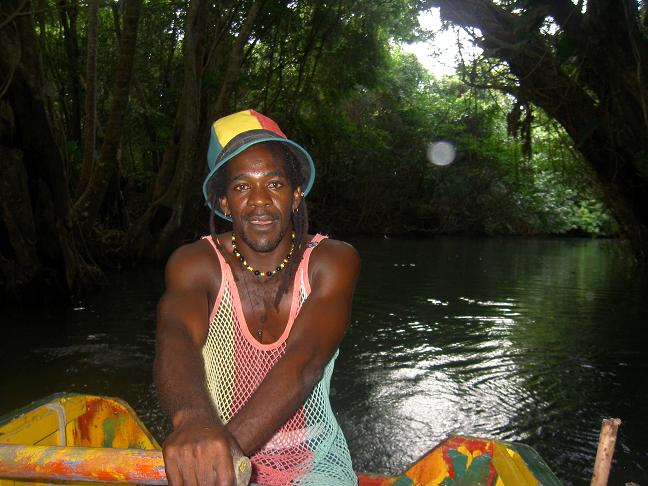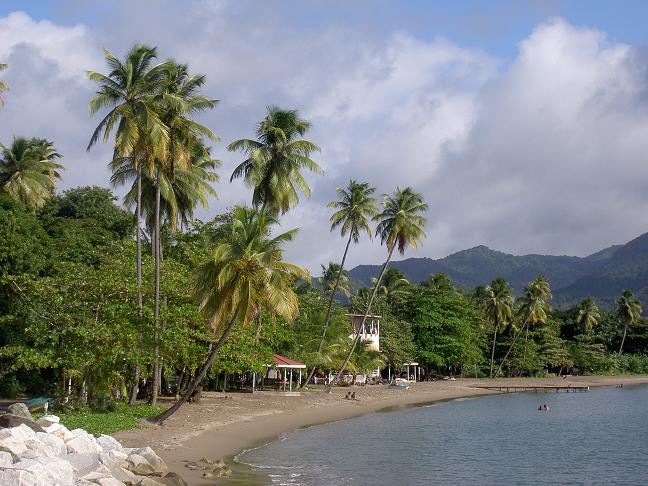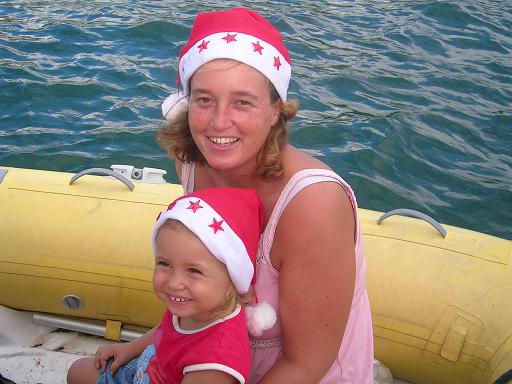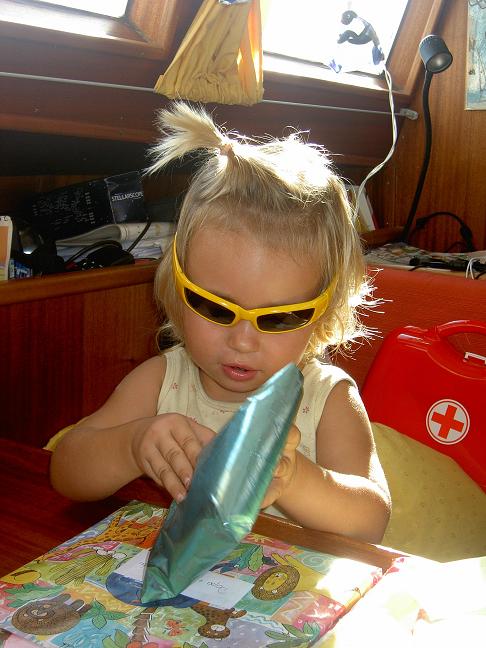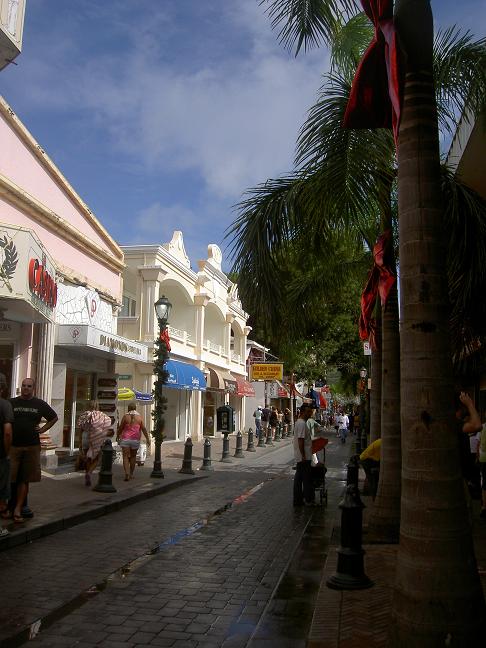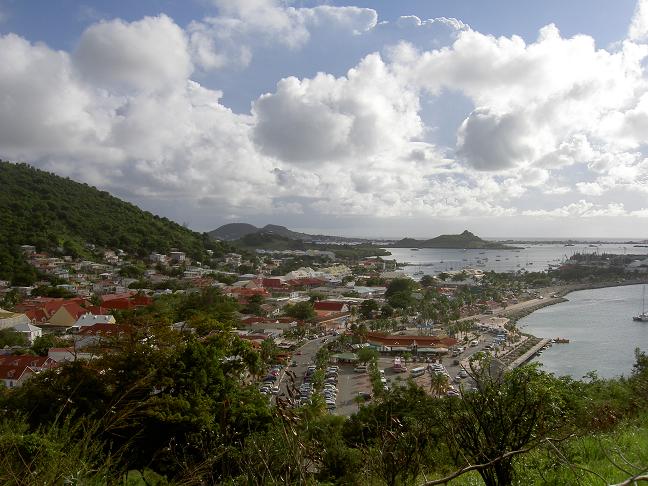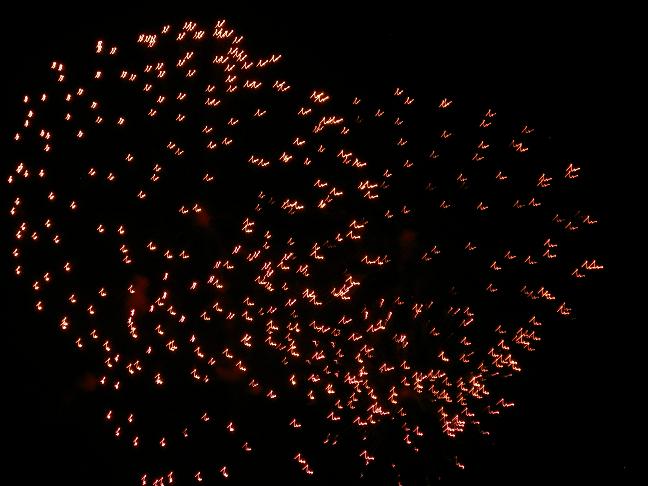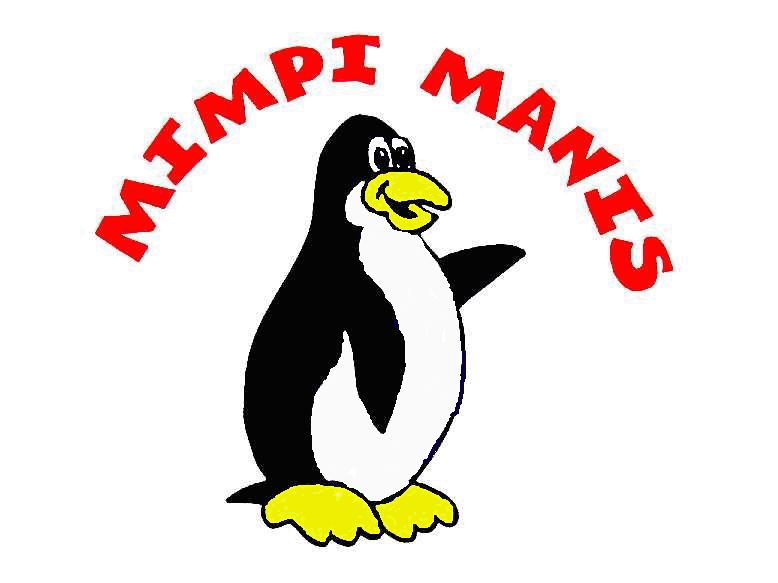
MIMPI MANIS
A family's dream of freedom becomes true
Diary
2006
October: we are on Isla Margarita (Venezuela) since one week now and have stocked up on food again. Shopping is a breeze here with all those shopping malls you are missing in the Antilles Islands. Our Diesel tank is filled up again and were able to do some minor maintenance works. And last but not least we have ordered a suncover and cockpit-cushions to be delivered end of October. To summarize, we are ready to leave for a trip and we have already decided where to go. We intend to relax on the outer islands of Blanquilla and Tortuga as we have met several sailors who really liked those places. But unfortunately we can not leave on our proposed day as our outboard has quit working and Stephan is not able to bring him back to live regardless of the effort he is putting in. Since several months we are always in trouble with this outboard, it stopped working from time to time without an obvious reason, we lost the stopping device (a small rubber nob) and had to kill him by pulling the choke! The throttle cable was rusting away, it sometimes took some effort to get it running and and and. OK this one is already 14 years old but that's no reason to behave so badly! To be on the save side we decide to buy another outboard but prices at the local dealers are not within our budget and there are only 8 and 15HP on sale but no 10HPs. According to the manufacturer of our dinghy we are only allowed to mount an engine up to 10HP and we don't believe a 8HP engine to be strong enough to make the dinghy planning. By accident we learn that the Swiss boat “Zangano” is selling a 10HP engine. As we know this couple since our stop in Agadir, Morocco we agree on a test and indeed we are planning and so we have a new 17 years old outboard worth the 300$. Lena also liked the “Zangano” as they have a cat and she likes playing with her but unfortunately the cat likes to have a rest more. So we store our old outboard on deck and think of a possibility to get rid of it with some benefit and not to sink it in the ocean. So we leave for Blanquilla with only one day behind schedule but happy as having a “new” outboard.
Early next morning we lift our anchor and motor to the northern coast of Isla Margarita to the small village of Juangriegos, 27miles away. For the first hours we have to motor along the eastern shore but when we pass the northeastern edge of the island we were able to set sails and sail the rest to Juangriegos. Early afternoon we arrive and only 5 other boats are anchoring here compared to the 90 boats in Porlamar. But the water is very muddy and visibility is less then 0.5m so it does not wonder that none of us wants to take a swim. Instead we get ashore and explore the town while walking. A nice church, several shops, internetcafe, a shoreline promenade with trees, ... and sewer covers breaking apart when stepping on them. Yes, it is really dangerous to walk there as those covers just make place for deep dark holes. Evi was so unlucky to step on a really strong looking cover and outsch she felt! Luckily the hole itself was no very deep but she got a deep cut on her lower leg and she was limping badly. So instead of walking around the town we stopped at a café and had a rest. Wiping of the blood and waiting for the pain to relieve a bit and than we walked/limped back to our dinghy only to see it covered in lots of sand. Sand was everywhere and either this was done by playing kids (we like to talk to their parents) or by some else who does not like dinghies. Two days later we made the same experience and again our dinghy was covered in sand. We really liked Juangriegos but when you always have to wash your dinghy after been ashore this town has some bad reputation. And we do not see reason to spent more time here.
For the next day we plan to go to Blanquilla. 60 miles are to cover and with a speed of 5 knots we will take 12 hours, perfect conditions for a night sail! And Lena is sleeping during night anyway so prepare everything and just minutes before leaving we see that two of four rivets at our trecker boom have come loose. Unfortunately we do not have spare rivets of the required size nor a huge riveter. So we postpone our sail for 24hours to go to the “ferreterias” tomorrow and hopefully get the rivets and be able to lend a riveter. But we will not risk to sail to outer islands with a trecker boom fixed with only 2 instead of 4 rivets. So next day morning we start our tour through the “ferreterias” of Juangriegos to get some 6.3mm (1/4inch) rivets but none are available. It seems that we have to fix the problem by ourselves and the resources we have aboard. So we drill holes of 4.8mm into the existing rivets and insert smaller rivets. They will not be as strong as the old ones but for sure we will be able to sail for some weeks till we get adequate rivets.
Having solved this problem we lift our anchor one day later than originally planed. The dinghy is tied on the foredeck, all loose items are stowed away and so we leave Juangriegos just at sunset. Wind was strong the whole day and even the days before but has calmed down a bit during the afternoon. Having motored out of the lee of the coast of Isla Margarita we still have 5Bft (20knots) of wind from the right side and so we able to sail the whole night at a average speed of 7knots. So instead of reaching Blanquilla at dawn we arrive there at 3:30 am. Luckily we had nearly full moon and so we were able to get to the anchorage and drop our anchor. We never had a nightsail as fast as this one! Going to bed and hoping that Lena will sleep a bit longer than usually are the only things we do after having safely reached Play Yaques on Blanquilla.
Next morning we were astonished by the colours of the water and the white sandy beach lasting from one end to the next. No signs of civilisation only some other sailing boats and one fishing boat. There is only one small settlement on this island on the southern coast, app. 4 miles away. Wildlife is luxuriant with hundreds of pelicans (Belaban according to Lena) and cormorants diving into the sea for a fish-meal. Having breakfast at such a place is worth all the efforts and we can watch all those birds for hours without getting bored.
Unfortunately there is a strong wind from the southeast of up to 35knots for the next 2 days. Our batteries are fully charged now as the windgenerator does not come to a stop. But the strong wind prevents us form enjoying the beach and snorkelling as there is some swell on the beach. But there is still lot of work left. Bread has to be baken, the ship needs some cleaning inside and outside and Stephan has to mount a ventilator in the salon and a new pump switch in the engine room. He also is making a holding device for our second anchor (Danforth) who has not seen light or water since we left one and a half years ago. Hopefully we will make more use of this anchor now as it is easily accessible. The Danforth anchor is said to give better holding in hard sand and grass. Lena is happy every time papa opens his toolbox and she can help him sorting his tools.
One evening Maren and Uwe from “Heavy Metal” drop by to have some small talk. They have left Hamburg one and a half years ago and plan to return in 2008. We first met them on Grenada and later on Isla Margarita. And it became a long evening with some glasses and even some bottles of wine. And at the end none was sober and getting into the dinghy can be a problem than.
Now wind has calmed down a bit and so we are able to enjoy the beautiful island of Blanquilla: turquoise waters, white sandy beaches, snorkelling sites full of fishes, crystal clear water where you can count sand grains in 10m depth. And you only have to jump over board to see these. We take long walks on the beaches, collect some mussels and corals and build sandcastles with Lena. With our dinghy we make a trip to “Baya el Americano” north of the anchorage. Here the sand is just a bit whiter and shore line is not so steep as at the anchorage. A natural arch with really good snorkelling is only 100m from the sandy beach and Lena likes walking on the beach and when going to the southern end of it, there is a small cave and we have a break in. Having a picknick under a sunshade and being alone for the whole day, what else do you need. But every rose has its thorn and here in “Baya el Americano” the thorn are the jelly fishes. Those here do not sting but who likes to swim with them?
We spent one week on Blanquilla and are sad to leave but as we intend to come back in one month we are not too sad at all. It's 65 miles southwest to the next island named tortuga, “Turtle island” (Spanish tortuga = turtle) and as weatherforecast predicts winds of only 5-10knots we will make lot of use of our engine for this nightsail. So we lift anchor at 6pm and 11 ½ hours later we stop the engine. But as fuel is incredible cheap we use this opportunity to fill up our water tanks (thanks to our watermaker) and so we are able to be fast enough to arrive in early dawn. Sometimes a ship is passing by and we have not much to do during our 3 hour watches. Next day morning at 5:30am we arrive at Playa Caldera on Tortuga and there is enough light to go directly into the anchorage which indeed is full of powerboats. It is Sunday and all those wealthy Venezuelans with their own powerboats have come to Tortuga to spent their weekend. We are shocked after the seclusion of Blanquilla but luckily most of them have left by 10am. So never go to Tortuga on a weekend. From Sunday noon to Friday evening the anchorage is used only by some sailing fishing boats.
Tortuga and Blanquilla are flat islands without natural water sources or the possibility of farming. Wildlife in water is great and so there are lots of fishing boats here. What else do they have instead of white sandy beaches and turquoise water? Not much, here at Playa Caldera there is a small hotel with only 6 rooms and some huts for the coast guard. The only possibility to get here is by your own boat or plane as there is a small airstrip. So some Venezuelans prefer to fly to Tortuga, have a swim, shower below the wing of their plane and fly back to their home on the mainland. So we keep to our usual day activities consisting of walks on the beach, swimming, building sand castles with Lena, ...
The official currency on this island seems to be fish. Two fisher approach us with their dinghy and ask for two hose clamps as they needed to replace some broken ones. Those can be really cheap if you buy bulks and when building your own boat you always buy bulks. So we gifted them two hose clamps and only a few minutes later we received 2 Red Snappers each 2kgs in return. So we had fish for the next two days. A couple of days later we decided to gift our outborder to the fishermen. Several trials did not succeed in making it running again and who will pay for a not working engine. We already saw us in having the engine for several months on sale and earning only 50$ or so, an effort not worth. As one afternoon a fishing boat passed us we waved them and asked them if they want to have the engine as a gift. They looked at us rally astonished and for sure they took the engine and left happily leaving the promise to bring fish next day. So next day they came back and we received 4 lobsters!!!!! So we had enough lobster for the three of us for dinner. We put them into a bucket with saltwater to cook them later. Lena liked chasing the lobsters till we finally cooked them. Really tasty!!!!!
After two days in Play Caldera we left for the next anchorage on the northern coast of Isla Tortuga, Cayo Herradura, only 10 miles further west. As there was really no wind we motored when the engine suddenly stopped working. There were several thunderstorms close by, water depth was only 10m and shore was within several hundred meters. We thought of our experience in Greece only one year ago when we had the same problem and were lucky to get the engine running again for only 1 minute, enough time to get us away from shore and set sails. Changing dieselfilter shows us that there is some clogged dirt preventing diesel from flowing through the filter. But the engine does not like to work again, so Stephan also disassembled the fuel line and cleaned it removing some more clogged dirt. After that the engine starts properly and brings us to Cayo Herradura. Another bay most people dream of, white sandy beaches for several kilometres and the water so turquoise never seen before. We walk on the beaches to the small huts of some fishermen and to the lighthouse and we enjoy swimming in the turquoise water looking as blue as a swimming pool. There is no infrastructure here, so no shops, no restaurants, ... Only a couple of times a year wind shifts to west, the rest of the year wind is coming from easterly directions. The bay is well protected against easterly winds but when it starts blowing from west, the water gets rough and the whole anchorage gets swelly. So we have to suffer as our boat is rolling heavily until we drop a second anchor on the stern to stabilize our position. Also the wind is not strong so a lot of mosquitoes find their way to our boat and they feed well on us. Burning mosquitoecoils brings some relief and our ventilators help us to get some cooling.
Every morning we are listening to SSB on 8140kHz USB from 8:45 to 9:15am. During season a weather report is transmitted at 9am and all sailors speaking German including the Swiss and Austrians meet there to talk to each other. And finally we managed to get into contact with “La Gitana” again which is moored in Puerto La Cruz. We have not seen Volker and Michaela since June when we were on Grenada. As they will leave for their leg to Panama and on into the Pacific soon we decide to visit them in Puerto La Cruz a last time as we will sail back to the Antilles and stay there at least another season. As we are running out of greenstuff anyway (only one onion and one lemon are left) we plan to stock up in Puerto la Cruz. Volker and Michaela are also happy to see us again and so we will meet them at the PMO-Marina and ask them to book a berth for “Mimpi Manis”.
65 miles are to cover and so we decide to sail during night again. 65 miles will take 13 hours and this is just a bit too long for a daysail. Also Lena is sleeping in the night anyway and so we can offer her a new anchorage next morning instead of a day sailing and being happy to get there just before sunset. We are lucky to have favourable winds till (NE-ENE 3 Bft) 2am and so we set sails and do not have to use the engine the whole night. We reach Puerto La Cruz at 6:30am at daylight and so we have a morning coffee with Volker and Michaela just after having moored. It's 10 months ago (on Gomera, Canary Islands) since we have been in a marina or moored in a harbour. There is lots of news to be exchanged and so we sip our coffee nearly till noon and the To-Do-lists on “La Gitana” and “Mimpi Manis” must wait. There is always something to do when you are in a marina, as it is only a step now to get ashore and no long dinghy rides.
For the next 4 days we spent much time with Volker and Michaela from “La Gitana”, relax in the pool at Bahia Redonda Marina and explore the canals of this development with our dinghy as far as Plaza Mayor, a huge shopping centre. While motoring through the canals you feel like being in Venice. Every house has its own mooring just in front of the terrace and those small canals meander below small bridges and really beautiful houses all built in the same style. No doubt, these houses are for the middle and upper class of Venezuela. And indeed they are not so expensive compared to prices in Germany. 140.000$US for 100sqm house with own mooring. We like this development because of its own style and the peace it's emitting. But on the other side there is lot of crime just outside the protected area and it is too hot for us and no season chances at all. A few months ago the manager couple of Bahia Redonda were shot dead when entering their premisses. So every sailor is asked not to leave the marina by foot but to make use of one of the taxis. Who wants to live in a country bearing the risk of being robbed or even killed while just walking down one block to the next shop to buy you some bread? So the sailors stick to their dingies or use taxis! The Coast Guard has regular patrols on the canals and is also watching over the 5kn speed limit and fines are hefty!
We spent a whole day at the shopping centre at Plaza Mayor, have lunch there and buy clothes for Evi. Having qualified comments from Michaela, Volker, Stephan and Lena makes it really funny. And instead of spending only a few hours we stay the whole day and at the end Lena fells asleep while motoring back to the marina with the dinghy.
In the evenings we have small talk while drinking wine and remember the days in the Mediterranean Sea when we first met. We also discuss your recent plans and the more recent changes. After being shy for some hours Lena made friend with Volker and Michaela and is joking with Volker. Saying good bye to Volker and Michaela gives us a hard time and we saw some tears in each others eyes. When will we meet again? As they will sail on into the Pacific and we will return to the Antilles Islands it will take years. We did not regret having sailed to Puerto La Cruz for saying hallo and good bye to the crew of “La Gitana”, although it is hard to say good bye to friends!
It´s time to say goodbye.... after 4 beautiful days we leave Puerto la Cruz wave good bye to Michaela and Volker. Before heading back to Isla Margarita we want to spent one day in Mochima National Parc on the mainland of Venezuela. The coast just east of Puerto La Cruz till Cumana is a really nice cruising ground with lots of secluded bays and gorgeous landscape. But again crime is on its rise and anchoring alone outside the settlement of Mochima is not recommended at all. During the last couple of years there were several incidents with piracy at gunpoints, nightly boardings, dinghy thefts, ... Bearing this all in mind you should not sail alone but have a buddy boat to assist you in case of an incident. In the afternoon, only 10 miles out of Mochima settlement a fishing boat is getting closer but not on a course that it should bump into us. Only a few minutes later it alters course right to our boat and only 20m away it suddenly stops and then it moves again on its prior course heading away from us. Nobody waved at us or did anything else like showing a fish on sale, but this was a strange manoeuvre.
There are only a very few sailing boats here in Mochima, much less than anticipated. But on the other side there are lots of dolphins swimming next to our boat and Lena is really enthusiastic in watching them. Hurricane season is coming to an end and so lots of boats are heading east again for the Antilles or going further west for Panama and the Pacific so it does not wonder that there are so less boats here in Mochima. We are glad seeing “Chougas”, a Canadian boat anchoring in a small bay near the entrance to Mochima bay and drop our anchor close by. We know them since Prickly Bay/Grenada and now to meet again here in Venezuela is really odd. As we are two boats now we decide to stay here for the night. Next morning hundreds of bees are crawling on the unwashed or with saltwater prewashed nappies of Lena, they are looking for salt! So the crew decides to push the captain into the cockpit, lift the anchor and move to another place while the crew will wait below deck for the bees to leave! We motor till the end of this bay which is more like a fiord and uninhabited for most of its shoreline. We stroll around the village of Mochima at the far end of the bay only to learn that this is a really sleepy town. There are only a few posadas (small hotels, usually family run) and restaurants which are still closed at midday. There's nothing much to discover here and looking for a place to buy us a beer and some juice ends in heading back to our boat as we did not found a bar or restaurant open. We motor for a small bay with a sandy beach just 2 miles out of the village and spent the afternoon there. We relax on the beach, lift up our dinghy and fix it on the foredeck to be ready for our next leg back to Isla Margarita during night.
We are a bit unlucky with the wind as we have some 3 Bft from ENE instead the promised SE. In addition current is also against us for the first hours. It's not really funny to motor 12 hours against wave and wind but we will have to do it again in one month when we are heading back to Martinique. Just after sunrise we enter Porlamar after a 3 weeks journey through the islands and to the mainland-coast of Venezuela.
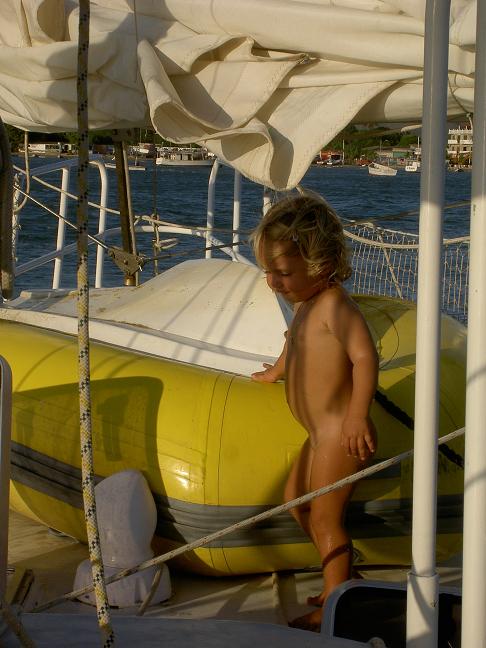
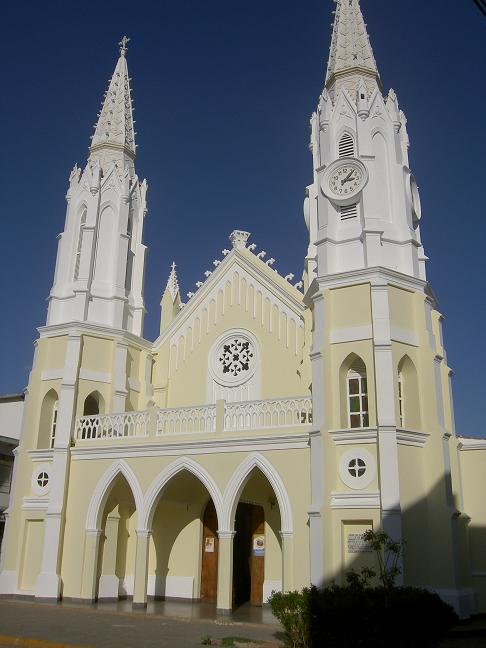
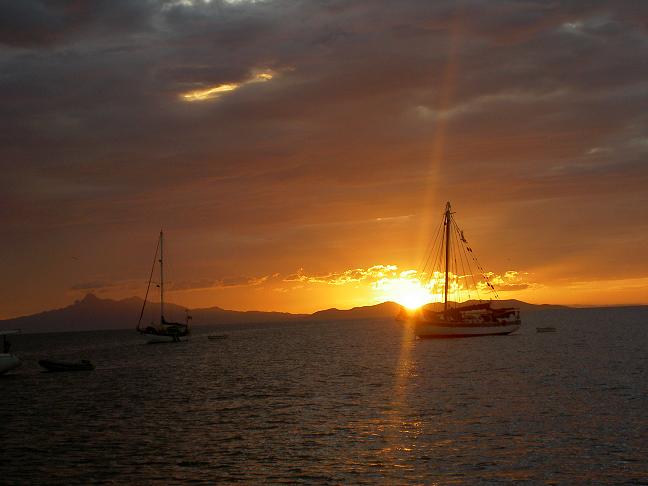
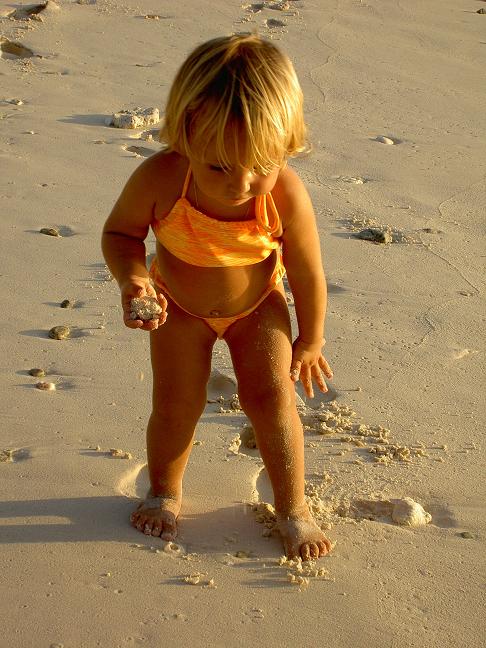
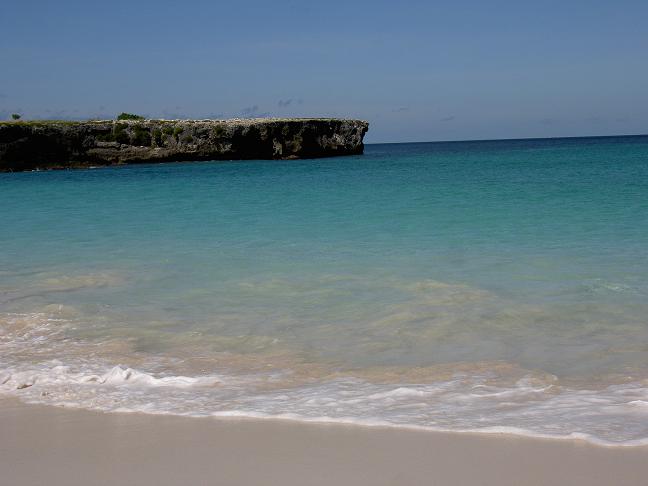
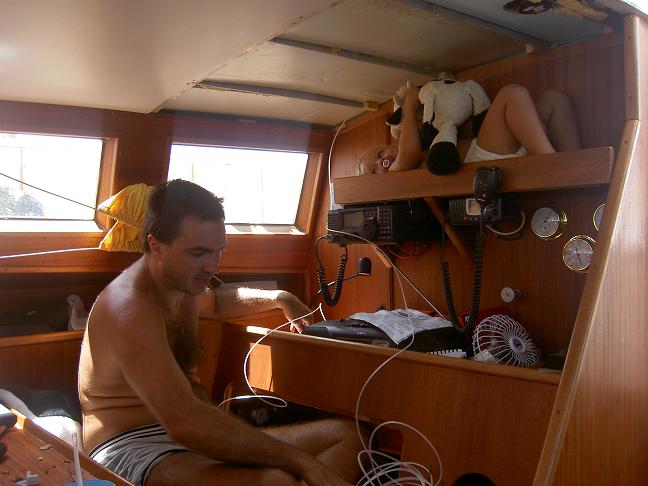
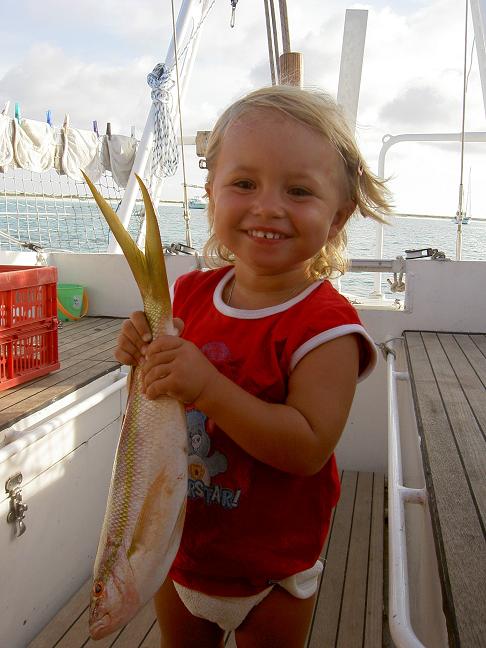
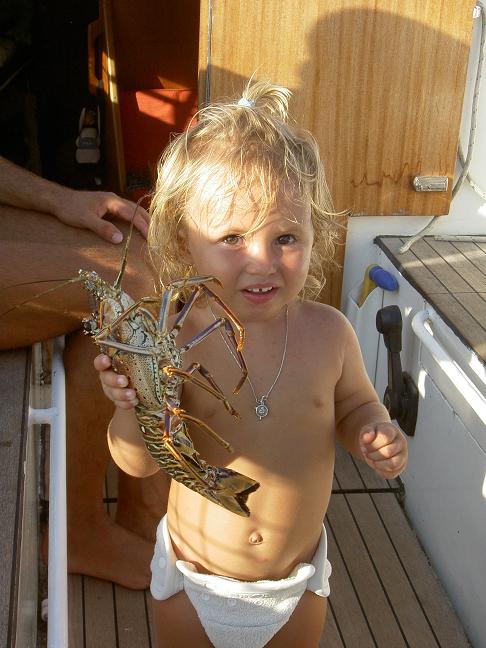
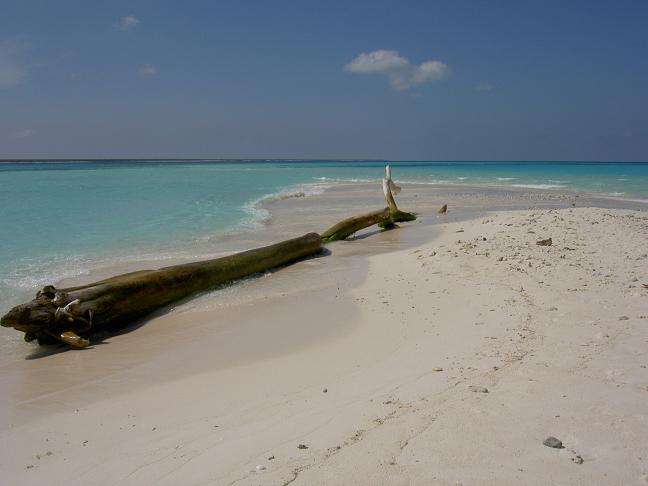
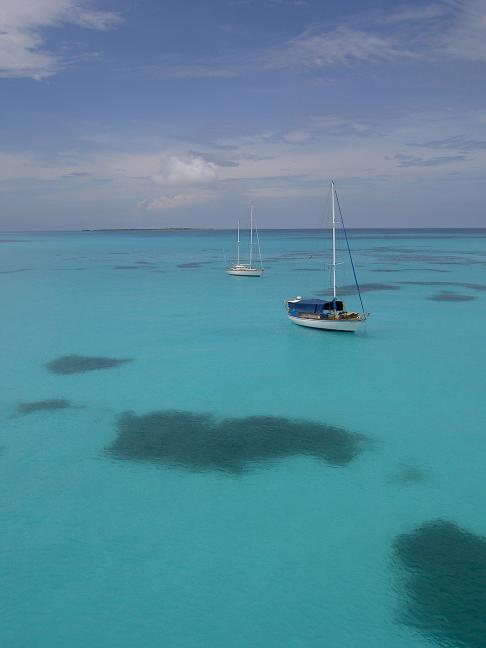
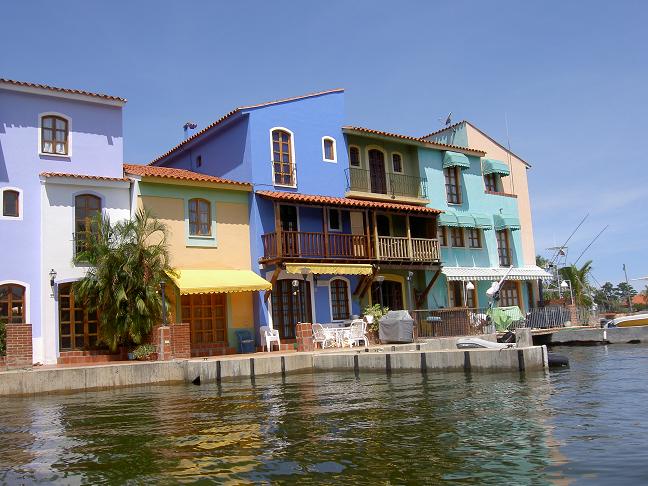
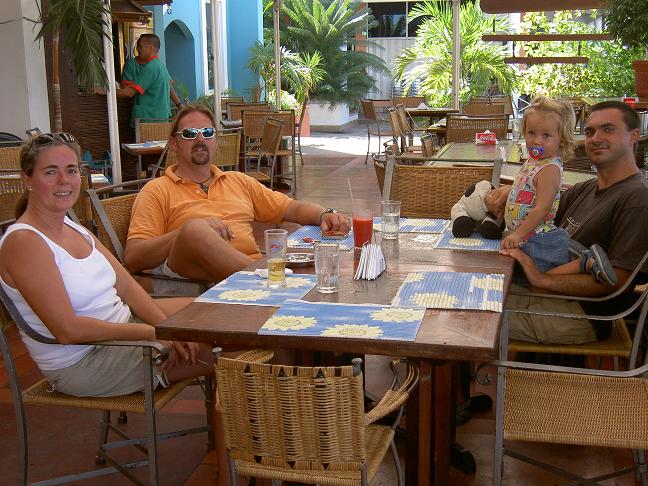
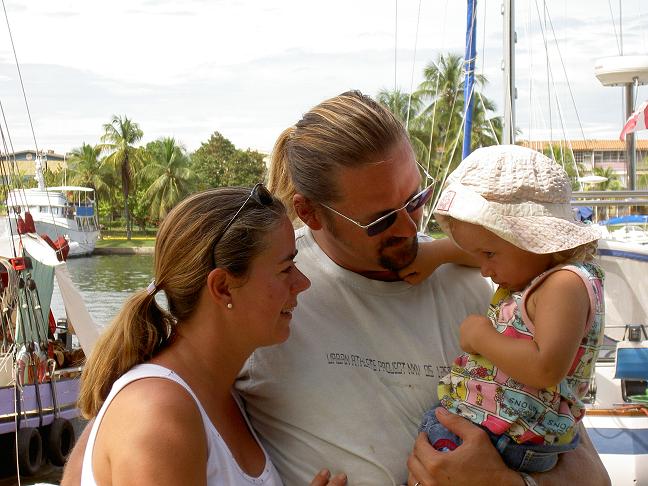
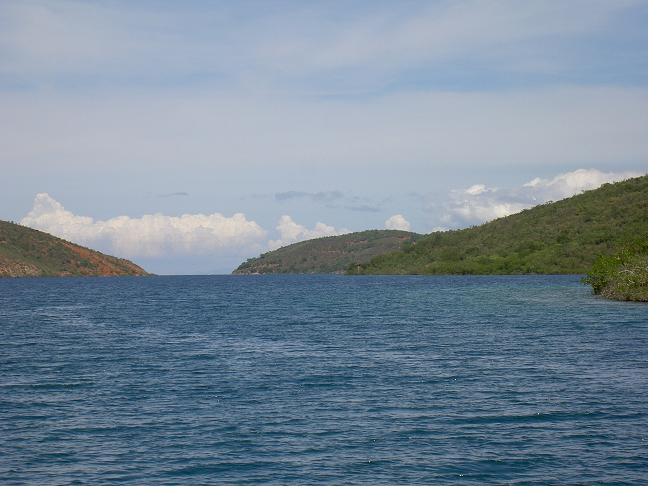
November: Back to Porlamar (Isla Margarita) we behave like all other sailors and we go shopping again. We stock up on vine, the fridge gets filled up to its top and also our diesel tank and our petrol cans are filled up with incredible cheap fuel. We only stop as no more space either in the fridge, the stowage spaces or the tanks and cans is available. Porlamar is indeed not a nice place but the best shopping in the Caribbean, pretty close to paradise. We did not found a cheaper place up to now and we will miss it when we are back in the Antilles. In the meantime we have ordered a awning and cockpit cushions, both now ready to be mounted for the first time. We like it from the fist moment and it was pretty cheap as well. Labour is so cheap that it is of no sense trying doing it by ourselves. As the awning covers the area from the mast till the stern we have shade from early morning till afternoon and also on top of the salonroof, a place not used up to now. So we are having siesta there and enjoy the shade, the gentle breeze and the view on the anchorage and using the sprayhood as backrest. We are lying on our new cushions, read a book and enjoy our cocktails! How did we manage it to live without cockpit-cushions and an awning for the last 1 ½ years? Up to now we only had some shade in the cockpit when using our Bimini and in the afternoon we had lots of sun so id did not wonder that we took our nap when Lena permitted) in the bed or the salon making extensive use of our ventilators. But we now have a penguin bill yellow “toldo” (Spanish for awning) and we are proud of it. Lena likes it so much that she is claiming the cushions for her leaving her parents sitting on the pure hard deck.
After a couple of days “Morgi” with Edgar and Claudia are coming to Porlamar too. We did not meet in Puerto la Cruz as originally intended and therefore we were happy to see them again. Edgar is showing us proudly his first fish he cached by himself, a 75cm long dolphin fish, enough to feed the five of us. And so we invite them for dinner on board of “Mimpi Manis”. Edgar and Claudia are donating their fish and we provide the rest like salad, wine, ... For the next days we meet regularly and discussing our plans for the near and further future and enjoy the cheap bee at the happy hour at “Sunset bar”. It looks like we have the same schedule for the trip up to the BVI´s. But we will return back to the south of the Antilles and they will continue on north for the Bahamas and head back across the Atlantic for the Mediterranean Sea. But for the next few months we can stick together and enjoy some more of the beautiful anchorages in the Antilles.
But we have to leave Porlamar now as Maria, a friend of us, is visiting us. After one week of exhausting travelling through Venezuela mainland she will relax for one week in a hotel on the north coast of Isla Margarita and then come aboard of “Mimpi Manis” for 9 days. She will be the first visitor since March! So we leave for the north coast and drop anchor in Bahia Pedro Gonzales, a nice bay with a small village. Unfortunately there is a swell coming in and so we have to drop a second anchor from the back to stabilize our boat. It´s only a 5 minutes walk to her hotel and so we meet frequently. A lot of stuff has gathered in Germany waiting for delivery and so Maria has to carry additionally weight when flying. A new WiFi-antenna, our autopilot, ... she really is glad to get rid of all this stuff. Those days in the hotel pass by very fast with exchanging news and so one day she moves with all her luggage to “Mimpi Manis” and same day evening we lift our anchors and set sail for the journey to Blanquilla, this remote island north of Margarita.
During 11 hours of smooth sailing with 5-6 knots of speed and a 10-15 knots easterly wind during the night we enjoy the bright stars and the calm sea. After having shown Maria the most relevant things like where to find cold beer or the sleeping captain she is sitting alone in the cockpit and glancing at the stars while having the first watch. Our windvane is steering “Mimpi Manis” safely through the sea and the one on duty only has to keep a lookout for other ships. Leaving enough time for reading a book, day dreaming, ... At 5am we finally reach Blanquilla and we start this day with freshly baked pretzels, white sausages and sweet mustard (the later two flown in by Maria), a typically Bavarian dish for breakfast! We like sitting in our cockpit on the new cushions below our awning, having turquoise water around us and the beach with its palms a short swim away.
The days on Blanquilla are indeed beautiful, weather is fine with lots of sunshine and a cooling shower sometimes and wind is just enough to start our windgenerator during daytimes and to ventilate our boat during night! This leaves enough time for reading, taking a walk, talking, relaxing, ... and the evening are always ending with some bottles of red wine. One day a fishing boat is gifting us 12 small mackerels and we are packing our grilling items together to have them grilled on the beach. We collect fire-wood, dig a fire-place and start the fire. We enjoy the fishes with cucumber-salad, potato-salad and white wine. Those are the days you will never forget!
In the meantime Maria is keen on fishing. For hours she is sitting on deck and holding or swinging the fishing line. And she is lucky to catch a fish, a 15cm barbel. But she is looking a bit surprised when the fish swallowed the bait. But who cares? Except that Stephan had to kill and gut the fish as Maria refused to. We are all happy that we can put some more fish into our Paella tonight. Together with the fish left over from the barbecue we will have enough fish and there is no need to open a tin!
Days are passing by much too fast here at the tranquil bay on Blanquilla. But we want to take a look at other islands and anchorages too and so we must count the remaining days and not to lift up the anchor too late. Our first idea was to stop in Robledal on the western coast of Margarita while sailing to the more southern island of Cubagua. But other sailors warned us not to anchor there because of security problems and boardings during the night in recent history. A very wise decision we did not stop there as when returning to Porlamar we learnt that a Icelandic Yacht has been boarded by three armed men and has be ransacked for several hours at the anchorage at Robledal just a few days before. (a more detailed report may be found at http://www.bluewater.de/revierberichte/s-amerika/robledal.htm). We were lucky not to have stopped at Robledal, maybe we would have suffered the same fate.
After 5 days on Blanquilla we gather all our belongings, put them back into the lockers and get the boat ready for a nightsail. There are 75 miles to be covered of which we only can sail 50, for the rest we have to make use of our engine. It took us 15 hours to cover this leg with an average of 5knots and easterly winds. Sounds like an ordinary sail except for an incidence at 3am when a huge tanker crossed just 50m ahead of us. Hearing his engines and seeing the lights just above you is not the thing you want to do during your shift. Evi who was on watch at that time told that the tanker came really out of nothing! Nevertheless she her suprarenal glands have released a huge amount of adrenaline into her blood to keep her awake the rest of the night! This incident shows the importance of regular looks out on the sea to prevent accidents. There is no help in crying “we have priority!” when it comes down to an collision with a bigship like a tanker! The more powerful one will continue, the other one probably sink. From now on Evi takes a look around every 5 to 10 minutes!
In the early morning we arrive at Cubagua and drop our anchor in a bay surrounded by white sandy beaches. Cubagua was the first European settlement in America. Nueva Cadiz was founded as a stronghold on the eastern tip of Cubagua. Indians were taken as slaves and forced to dive for pearls. Hundred of Indians died due to whipping and beating to force them to work. At the height of the pearling industry Cubagua provided Spain with pearls equal to the gold from Inca land. 820 pounds of pearls were exported in one year alone. But after a short period of time the pearl beds were plundered and pearling industry moved on to Coche and the mainland. Today only some remnants like foundations of the houses are to be seen and pearling is prohibited on Cubagua. Cubagua itself is a dry island with yellow-brown hills and sandy beaches. Vegetation is only cactuses and other succulents. Cubagua is uninhabited except some fishermen with their families and a research station. One of the main attractions is a sunken car ferry from the 70s which makes for good snorkelling. But we do not like to snorkel here as we saw lots of stinging jelly fishes while swimming. Also the beaches are not so white and so pristine as on Blanquilla and so we decide to wander around for a short time and leave next day morning. We left some T-shirts and pens with the families and learnt how life is on a tiny and secluded island like Cubagua.
So next morning we lift our anchor and motor to Coche only 12 miles east of Cubagua. Coche is developing into a touristic highlight with high standard hotels on white beaches and Kite-surfing-schools, jet-ski-rental, windsurfing, ... On the weekends lots of people meet there like locals and day-trippers plus the tourists. But the water is very cloudy here and there are also stinging jelly fishes. So we do not swim but splash in the shallow water. So we are not sad when we had to leave early next morning for the last leg back to Porlamar. At sunrise we lift our anchor and motor for 4 hours to cover the 16 miles back to Porlamar. This time it is motoring against wind and current and no smooth sailing. Maria seems to like the last hours, she is sitting on the deck with Lena and keep a strong lookout for the whole time. Maria was indeed a good crewmember from the first beginning. She never got seasick, did her nightwatches and helped when getting the boat ready for the next leg. And she never said no when it came down to have a cocktail, a beer or some red wine.
After having reached Porlamar and checked the latest weather forecast we decide to leave for Los Testigos the same night just after having said good bye to Maria. As the next visitors will be in Martinique in 10 days we do not have too much time to wait for ideal weather and have to deal with the one we are expecting to get in near future. Sailing from Isla Margarita to the Antilles Islands is sailing against the prevailing winds and the Guyana current setting Northwest with 1-3knots. For tonight winds will be 15knots from 100° (just a bit south of east) and will shift to ENE with 20-25knots next day! We would really like to stay one more night and have some sleep but we do not know when there will be another weather window for the leg to Los Testigos. Having dropped our anchor in Porlamar we must stock up on greenstuff as our fridge is nearly empty after 19 days on remote islands. Although it is Sunday we do not have a problem as the bis shopping centres are open Sundays too. So we go to a Supermarket by taxi and stock up with greenstuff, bread, ...
We spent the rest of the day with stowing away our shopping, packing Marias backpacks, having a nap with Lena and a smalltalk with Edgar and Claudia from “Morgi”. For saying good-bye we decided to go to a restaurant and as Maria has to be at the airport at 5am she will spent the night at a hotel not far from the airport. So we go to “El Molino”, a small hotel with restaurant owned by a German lady, by taxi. Angela, the owner is living on Isla Margarita since 20 years and she has built this mill and run since that time. So we are lucky to get served real German dishes with lots of side dishes we have missed since years. We really enjoyed this evening and thought of the last 10 days we have spent together with Maria on “Mimpi Manis”. It was already dark when we said good-bye to each other and left for the port of Porlamar. Maria will fly to Los Roques the next day to spent there 2 days and then return to Germany.
After Lena had went to bed we prepared “Mimpi Manis” for the nightsail to Los Testigos, like dismounting the outboard engine and lifting up the dinghy. At 9pm we lifted the anchor set course to Los Testigos. Although we had a favourable tide we had to fight against ½ to 1 knot of current. Waveheight was app. 5ft and so the bow was rising in each wave and hammering down when the top of the wave was reached. Trying to sleep in the front department was impossible as it was like lying in a very fast elevator, only Lena slept the whole night. Not a nice leg to be covered, but we have known this before. After 12 hours we finally reached the anchorage just before the strong NE wind came up. We were lucky that Lena took a nap in the early afternoon, so we could gather some more sleep!
To cut the long leg from Los Testgios to Martinique in manageable distances we decide to sail to Bequia (St. Vincent and the Grenadines) first and then continue to Martinique a few days later. Sailing to Bequia is again motoring against wind and current and as the weather will be favourable for the next 2 days (easterly winds of 15 knots or less) we decide to leave next day after arrival at Los Testigos. In the late afternoon we lift the anchor and set direct course for Bequia. Again we had to make extensive use of our engine and fight against the waves and getting the feeling of living in an elevator again. During the night we had drift of up to 40° and 2 knots and when reaching the northern tip of Grenada drift went down to 15° and 1 knot. At that time we set sails and sailed north till we reached the same latitude than Bequia. Unfortunately we had a strong westerly current again and so we were not able to sail directly to Bequia but ended 25miles west. Then we started the engine again to safely reach Port Elizabeth on Bequia at sunrise. At 8:30am we drop anchor in Admiralty Bay after 39 hours of sailing/motoring. We covered nearly 200 miles although it should only be app. 150 miles going the direct way. But these are the facts you have to deal with when going against wind and current!
We relax for two days to get rid of the sleeping deficiency and to have a possibility for Lena to walk around ashore. We also like walking through Port Elizabeth, a tiny and picturesque village we already know from our first visit half a year ago when we sailed south. We also get our gas-container filled and a zipper exchanged in the foresailcover. We also meet some friends like “Green Coral” a Swiss couple (Peter and Rosmarie) who are also heading back north.
On the afternoon of our second day we are getting restless and lift up the anchor to cover the last leg for Martinique. 100 miles have to be covered and we decided to sail on the windward side of St. Vincent and then to decide if we go in windward of St. Lucia or on its leeward side. Wind is supposed to be EastSouthEast and 10-15knots, seas 5-7ft. So we leave Bequia via the Bequia Channel to get on the windward side of St. Vincent just to learn that wind is only 5-10 knots and from EastNorthEast and decreasing. So we decide to go to the leeward side of St. Lucia and motor to its northern tip and see what weather will be there. Sea was so calm and we had a favourable tide so that we could maintain a speed of 6 knots! When we reached the northern end of St. Lucia in early sunrise wind was indeed coming from EastSouthEast with 5-10 knots and increasing. So we were able to set sails again and sail all the way (25 miles) to St. Anne on Martinique. It is 9am when we drop our anchor in French waters. It took us 72 hours since Porlamar and we are happy to have finally reached our destination. We celebrate by cooking our last white sausages and baking fresh pretzels.
Shortly after we have dropped anchor a boat from French Customs is drawing circles around us only to ask us where we came from and how many people we are. At that time we were just covering our sails and clearing up all this stuff you need when sailing and not when anchoring. Having swallowed the last bit of our sausages French customs comes back and want to board our boat. That's how you realize that you are in France, they wait till you have finished your meal, eating is not only to fill your stomach but a kind of holy ritual. Now they ask us questions like how many people, weapons, arrival time, ... Then they start to search our boat for illegal drugs, even the blackwatertank must be opened to satisfy them that we are no smugglers. We have a bad conscience as we have not checked out in Venezuela and therefore can not provide the required papers. It is not common that European boats are searched in French waters in the Caribbean but that's theory and now we will see what reality will bring. But they don't care at all! But altogether they are friendly and it seems like a routine and not a specific search. If we had loaded a ton of drugs and weapons into our engine room, nobody would have found it. After half an hour they stop their search and ask us on our foresail. Why don't we have a roller foresail like all the other boats, how does it work, and are we happy with it, ... They ask us so many questions but not one regarding the papers from Venezuela. When we checked in with customs and immigration next day in Le Marin nobody wanted to see our passports, only the boat papers and again no question regarding the check-out papers from Venezuela. But remember when you want to clear customs and immigration in “St. Vincent and the Grenadines” and you can not provide the check-out papers from your last country it will cost you 500$EC (200$US), a hefty fine!
The last days before our visitors are arriving pass by very fast. We have to organize some things like buying greenstuff for the next week, shop for some presents for Santa Claus, clean our boat inward and outward and getting some sleep. Having done this we leave Le Marin and head for the agreed meeting point at Petit Anse de Arlet, 15 miles to sail. And here we wait for our family to arrive.
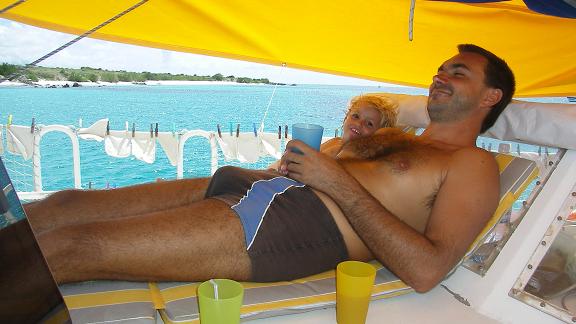
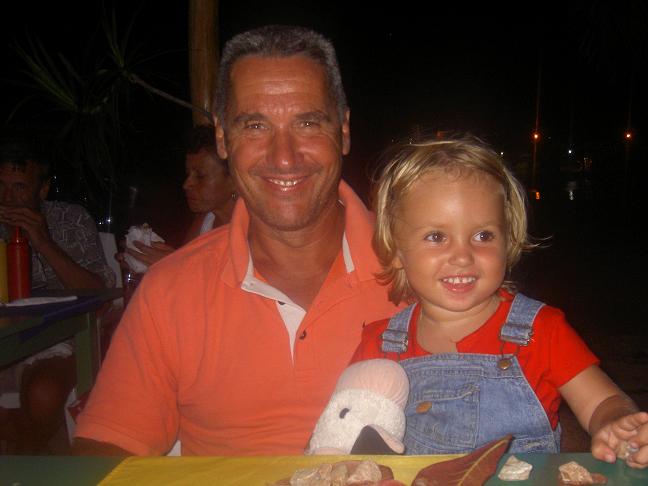
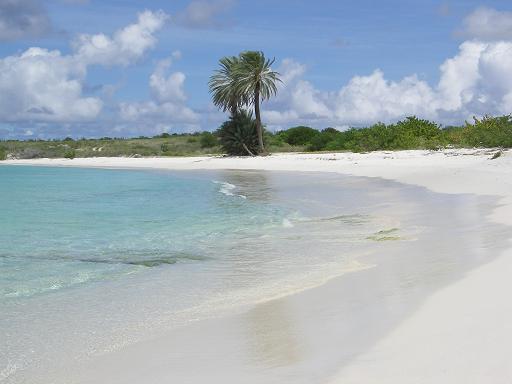
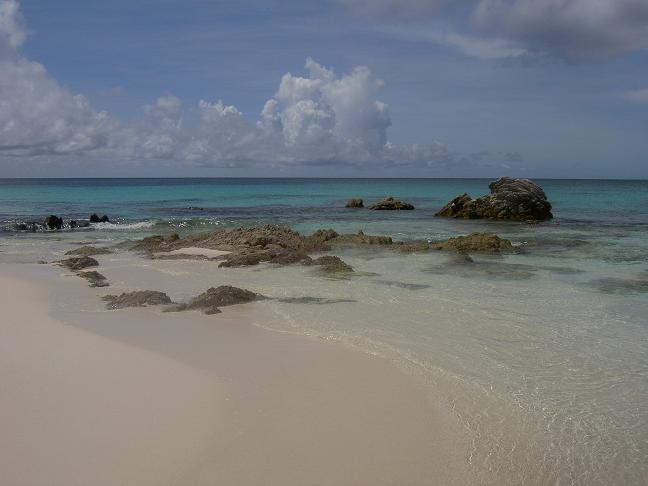
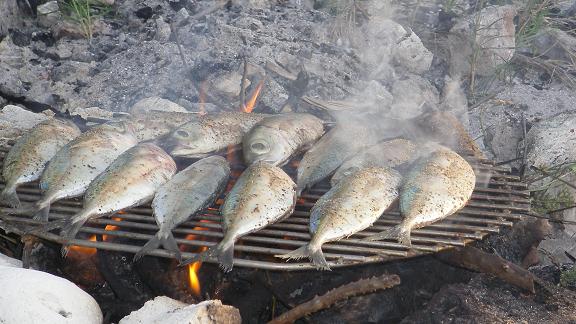
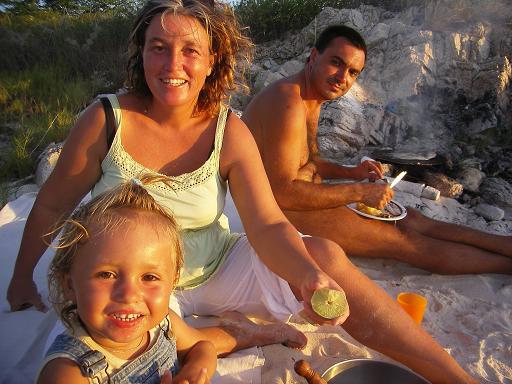
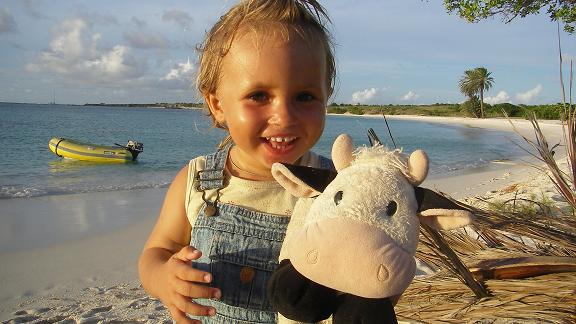
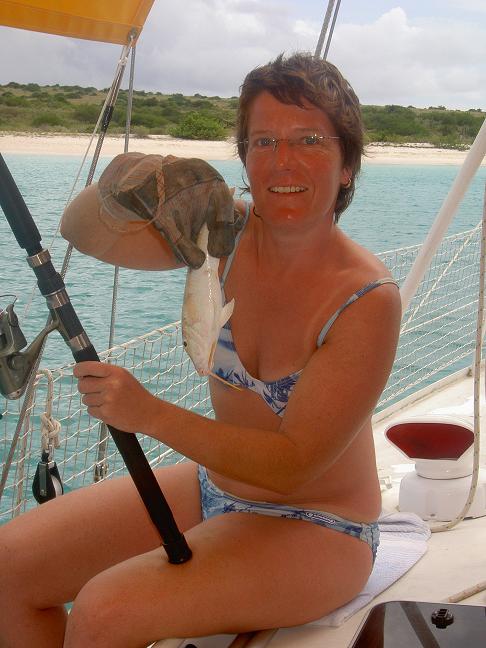
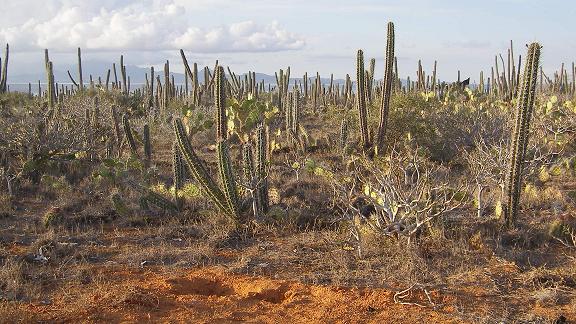
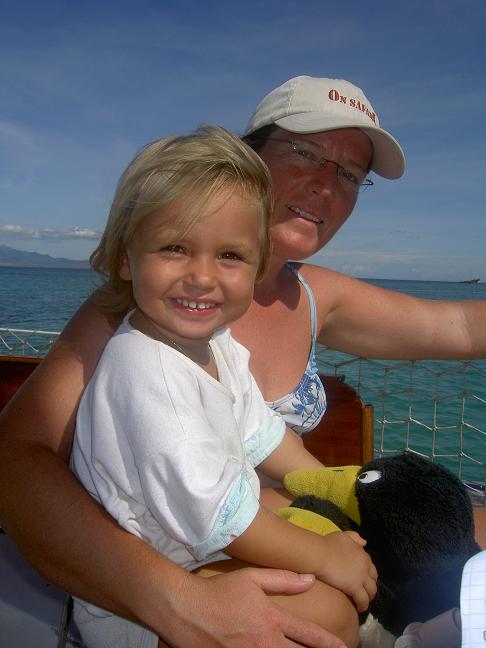
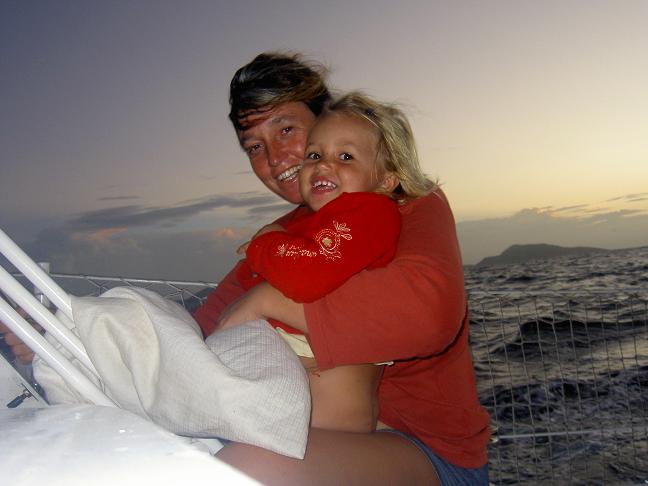
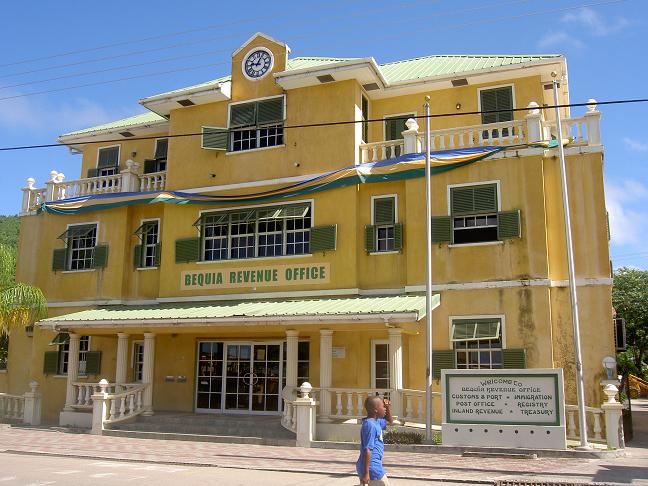

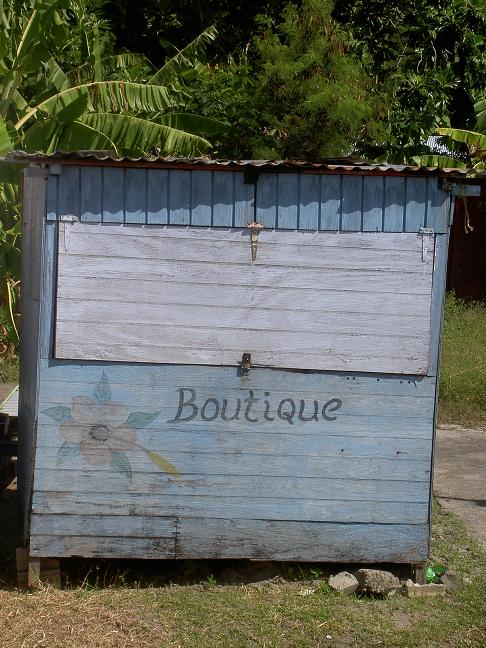
December: we are at the airport in Fort de France and wait for our visitors to come. While we were ahead of the schedule the plane had 1 hour delay so we had plenty of time to stroll around. Evi's father and brother with his wife Anne and the two kids Bastian (2.5 years old) and Marie (11 months) are visiting us. Since a few weeks when we first told Lena that family is coming she is now very eager to see them. Although it is already 10pm she is not tired at all and runs around in the airport while waiting for them. It is 8 months since she last saw them and she recognizes everybody of them by name within a few minutes again. They will stay 3 weeks and those will be 3 weeks filled with lots of activities on the islands and familyfestivities. Grandfather will sleep on our boat while the rest have rented an apartment in the small village of Anse d'Arlet in the bay of Petite Anse d'Arlet. 5 adults and 3 kids on board of our “Mimpi Manis” would have been too much!
We stay on Martinique for 10 days and enjoy the evening at their apartment while having a BBQ with swordfish. We also stayed on the beach whenever weather was fine. Unfortunately it rained a lot! Every couple of days we explore Martinique with the rented car and visited the Rum-Museum at St. James on the eastern side of the island. But they only produce rum from February to June while sugar cane is harvested and in the meantime they work on maintenance. So guided tours where not available but the museum was open and a train was running on a small track through plantations of sugar cane and bananas. Especially the kids liked to go by this slow train. After having tasted some of the rum we bought some bottles and went on to the peninsula of Caravelle with her traditional fishing villages, beautiful sandy beaches and the Chateau Dubuc, a ruin in a beautiful setting left over from the 17th century.
We also visited the southern tip of Martinique with its long white sandy beaches at Les Salines. But there are high waves coming in and so swimming is not advisable for our kids. Also the northern part with the former capital St. Pierre is on our list of places worth visiting. St. Pierre was devastated in 1902 when a pyroclastic eruption of a nearby volcano killed all its inhabitants of nearly 30.000 except one prisoner who survived thanks to the thick walls of the prison. After that the capital was moved to Fort de France and St. Pierre was rebuilt in a much smaller size. A museum worth visiting and some ruins can still be seen. After lunch we continued north to the black beaches of Le Precheur for some relaxing and swimming. But we were unlucky with the weather and several squalls with lots of rain during the day did prevent us from enjoying the beautiful beach. Rainy season has not come to an end up now to and even during rainy season in summer we did not get soaked so often.
We enjoy having family visiting us and especially Lena is eager to play with Basti and Marie and soon after breakfast she wants to get ashore to see her cousins. The three kids liked each other from the first beginning and they keep us on a run to look after them. So no more short naps after lunch and a daughter not falling asleep before 10pm. We liked those times when Lena was having a 1 to 2 hours nap after lunch and slept from 8pm to 7am, will those times return when family is leaving? On 6th December Santa Claus is coming and knocking heavily on the door and he left 3 small sacks with presents and sweets for the kids. Lena is getting her ball she liked to have for several weeks now! Even days later she tells everybody in her own words that Santa Claus has come and left some presents and her eyes are so bright! “Mizilaus, Schenke, Ball, Sokolaaaade, ...”
10 days on Martinique pass by very fast and so we pack together our belongings and also the family is packing for the trip to Dominica, a nightsail. We put everybody on our small boat and also it was a tough task to store all those items like a second buggy, two huge backpacks, a maxicosi and and and, we are astonished that we were able to move through our ship and everybody has found a place to sleep. It's not easy to find 8 berths on a ship only having 5 but it worked out as one was on duty anyway and the salon floor was occupied too and kids don't take up much space. At 5pm we lifted our anchor and a heavily loaded “Mimpi Manis” is making its way north to Dominica. Anne and Marie are going into their berth very early this evening to prevent getting seasick. As Anne is still breastfeeding she can't make use of our extensive medication we have aboard. Also Lena is falling asleep soon after, maybe the last days were too much activity for her.
90 nautical miles are to cover and for the first hours we had a smooth sail in lee of Martinique with no waves at all. But when we reached the passage wind become stronger (20knots, 5 bft.) and waveheight was up to 3m. As we had to sail against the wind it was a rather rough but fast ride with 7knots of average speed while sailing in the passage. As previously mentioned some of the crew were not used to live on a sailing boat which is moving in any direction without warning and having a bow going up and down like an elevator and always leaning on one site and so it does not wonder that some of the newly shanghait crewmembers got seasick. Basti was vomiting his lunch and prevented his father from becoming some sleep. Only the two youngest ones, Marie and Lena were able to sleep the whole night, for all others it was a night with less sleep. Just before midnight a huge freighter was crossing our course and when it was only 50-100m away we altered course although we had priority but who cares if a freighter built of several thousand tons of steel is ramming a light built aluminium sailing yacht and sinking it. So we tacked and let the bigship pass by. Maybe there was enough space so we would have safely passed by without tacking but we did not want to test it.
At 1am we reached the southern tip of Dominica and soon wind decreased to zero and waves were just a few centimetres high. So we start the engine and got a smooth ride along the lee shore of Dominica except the noise from the engine and the watermaker running. At sunrise we reached our destination, Prince Ruppert Bay at Portsmouth on the northwestern shore of Dominica. We drop our anchor in the southern part of this huge bay and are glad to be here. We cook some coffee and enjoy the pain au chocolate still left over from Martinique. Shortly later Bernd, Anne, Basti and Marie are leaving to look for their prebooked hotel. As there is no dinghy dock and the water is brown due to a river and turbulent from waves, it is not an easy task to get ashore. And shore itself is made of stones and gravel and so Stephan decided not to get ashore with the dinghy but to wait in tight deep water for Bernd to carry all the luggage ashore. So he waded ashore while carrying the luggage atop of his head. He really looked like an African porter on one of those old expeditions. From time to time a wave is coming in, higher then the others and so it does make wonder, that he was not drowned. But nothing got wet and every item safely reached the dry land. We are so sorry we have not taken a photo, but we were too far away! And words are not so good describing it like one picture.
Having seen this we decided to move our boat next morning to the northern part of the bay close to “Big Papas Restaurant” where the water is much calmer and clear enough to count sandcorns in 8m depth and a dinghy dock is provided for easy access. So we have no other forms of communication then to make use of our VHF-equipment. Luckily we have a hand-held VHF we can borrow to the family so they can call us.
The days on Dominica are as rainy as the ones on Martinique but this does not prevent us from exploring this nice green island with its friendly people. Knowing this island from our first visit as green and very beautiful we decided to visit some of the natural highlights again. We walk up to the nearby Fort Shirley built in 18th century and and abandoned in 1854. There is a beautiful view on Prince Ruppert Bay from there and also some trails worth to be hiked. A few days later we rent a car to go to the Trafalgar waterfalls and Titou Gorge in the southern part of the island situated in the Morne Trois National Park. Swimming through Titou Gorge is worth despite the “cold” water. When the walls as high as 20m get as close as 2m and after 100m you reach a waterfall. We also drive up to the Freshwater lake, a water reservoir and the biggest lake on Dominica, also used to generate hydropower for electricity. Here it is really cold and foggy. This lake is situated in the crater of a volcano and not far there sulphurous springs and a boiling lake, still signs of volcanic activity. On our way back we stop at the “Syndicate trail” to walk through dense rainforest and maybe someone else is lucky to see one of the rare species of Sisserou the national bird of Dominica. But also the drive through plantations of coffee, bananas, orange trees, .. is worth going here.
Another highlight is going on the “Indian River” close by Portsmouth. This river meanders through dense forest with mangroves on each side. A boatride of 20 minutes brings you to the upper end and there someone can walk through the forest or have a cold drink at the jungle-bar. A few days earlier we were unlucky as it was raining the whole day but now weather got fine again and so we had the a pleasant paddle tour up there. Rasta man Budah gave his best to explain every tree and wildlife we saw. So we learn that the second part of the film “Pirates of the Caribbean” where photographed here. We really enjoyed this trip.
For the last few days we relax on the sandy beaches and tasted all restaurants on the beaches. It will take some time till we will see them again and so we do not get sick of talking with them while the kids play on the beach. But after 3 weeks of holiday the family has to return to Germany and we are left alone on Dominica as they go back to Martinique by ferry just three days before X-mas. We are sad that they must leave and we wave good-bye when they enter their bus taking them to Rousseau. Especially Lena is sad as she liked playing together with her cousins Basti and Marie. Should would have liked to fly with them to Germany and it was a hard job to satisfy her with the promise that we will fly to Germany in a couple of months.
One day after family has flown home we lift up our anchor and head for Iles des Saintes, just in between Dominica and Guadeloupe. We did not like the idea of spending X-mas on Dominica as this means beach party with very loud music from dusk till dawn and it is not music you usually play at X-mas but Reggae. We once had this experience on Eastern and so we head for a different place. Iles des Saintes looks nice for this as it is a part of France and therefore catholic and from our last visit there we know that there is a nice church and the settlement is a small and pleasant village. It is just 18 miles and even when starting at noon we are able to cover this leg till 4pm.
In the meantime the 23rd of December has shown up on the calendar although we do not have any feeling of X-mas. Looks like we are missing snow, the cold, a X-mas tree and the X-mas cookies. Although we got some X-mas cookies from our family when they visited us, there were none left! So how to get X-mas feeling when all the necessary items and surroundings are missing? Only Lena is very eager to see Christ-child delivering the presents. To be sure that it won't miss us she even called it on VHF Channel 74 after we have moved to Iles des Saintes. Daddy is standing on the foredeck having the hand-held VHF with him and is answering her call with a deeper voice pretending to be Santa Claus and in charge at the moment as Christ-child is busy. Lena is telling him that she liked to have her presents delivered to Iles des Saintes instead of Dominica! Mama is prompting her, but to summarize she did her job very well! At other times when we asked her to talk to someone on VHF she usually does not say one word or whispering in a low voice so nobody understands her. When daddy returned she proudly is telling him that she has called Santa Claus and that the presents will be delivered to Iles des Saintes now. It gave us a hard time not to start laughing out loudly.
X-mas: the anchorage is getting more crowded from one hour to the next in front of Bourg des Saintes. It seems that all boats from Guadeloupe have left their marina berths to celebrate X-mas at a more secluded bay on outer islands. It does wonder that there was no collision between all those boats, although some get really close. Early morning we can unpack the first presents and cut a birthdaycake as our personal Christ-child has his 37th birthday, yes daddy is one year older! The crew from “Morgi” even serenaded him a birthdaysong via SSB! A few hours later we are working hard on getting everything ready for the evening: the turkey is in the oven filled with raisins, apple and bacon, Igname (also known as taro) is cooking, spinach is ready to be cooked and Lena is luckily having a nap. Now mama has some time to get all those presents out of the cupboard, set up a candle with some penguins and also to mount our penguin light. Now it looks like X-mas on “Mimpi Manis” and we are having a really nice X-mas on board. At 9pm we go to the church to celebrate with the local people. In the end all seats were occupied and some people had to stand outside, but we were lucky to get some. Lena really liked this day with all its presents and being in a church for the first time and joining a mass. She falls asleep after half an hour and we carry her back to the dinghy and aboard where she continues to sleep.
On the 26th we lift the anchor leaving Iles des Saintes and heading for St. Martin. We intend to cover the 175 nm by two legs. First we want to sail to Deshais on the northwestern Tip of Guadeloupe during the day and starting next day the longer leg to St. Martin. Wind is from ENE and 5bft. this means that we are having wind from the side enabling us to sail fast. But on the other hand we are having the waves from the side too, so it will be a rocky ride with quite some rolling. With an average speed of 7 knots we reach the southern tip of Guadeloupe after only 1 ½ hours and having reached lee of this big island waves are decreasing to really zero. Also wind is decreasing and becoming unreliable as it is now coming from anything in between NE and SE with a force of 0-5bft. Sailing in these conditions is not easy as one has must always be in the cockpit on duty to interfere and steer by hand if “Mimpi Manis” is leaving its course as the windvanesteering must be adapted to the conditions whenever direction or force of the wind is changing. So we take down the foresail and start the engine. As we need to produce some water anyway, it was easy to decide on this, as now we can make use of our electrical autopilot and top up our watertanks which intend to be empty very often. At 3pm we reach Deshais, a small village situated in a pretty bay. Soon after having dropped the anchor we get ashore and luckily find a playground with two chutes and lots of toys. Here Lena is romping till she is falling asleep.
Next day we start for the second leg to St. Martin, a 140nm are to be covered and this will take app. 24 hours. So we lift anchor at noon to be sure to arrive during daylight whether our average speed will be anything in between 5 to 7 knots. After 1 hour motoring wind is coming up so we can set sails. Unfortunately the waves are up to 8feet high and so it is a rough ride again. Weather is not very pleasant and trade winds are spotted with lots of squalls bringing wind of up to 6bft and heavy rain. Thanks to the DUPLO toys Lena was gifted on X-mas she is playing happily with them for hours. Wind is decreasing a bit during night and waves too, so we can get some sleep and maintaining an average speed of more than 6knots. We pass by the islands of Montserrat, St. Kitts and Nevis and St. Barth and at sunrise we see St. Martin just ahead of us. After 22 ½ hours we drop our anchor in Marigot, the capital of the French part of this tiny island.
St. Martin is unique on this world as this tiny little island is divided into a northern part belonging to France and therefore Europe and a Dutch part in the southern part, called San Maarten. The French part is a part of the “Departement de Guadeloupe” together with St. Barths and is having the same status as Martinique, La Reunion and French Guayana. The currency is Euro, it's a domestic flight to Europe, ... The Dutch side is part of the independent country “Nederlands Antillen” which was formed out of the former Dutch colonies in the Caribbean Sea. This country is consisting of the ABC-Islands (Aruba, Bonair and Curacao of the coast of Venezuela), San Maarten, Saba and St. Eustatia. The capital is Willemstad on Curacao and as it is still a part of the kingdom of the Netherlands. So its foreign policy is ruled by the administration in Den Haag whereas for internal policy they are totally independent and having their own currency not many people have heard of, it's called Guilder and abbreviated NAF. Beside of some nice bays and beaches there is not much to be seen here. As both parts are a duty free zone it does not wonder that lots of cruise ships drop their passengers here for some hours.
Having dropped the anchor we explore Marigot, looking for a supermarket to stock up on food, passing immigration and customs or just walking through this nice town. We have some ice cream at the Marina Port Royal and walk up the hill to the remnants of Fort Louis. There are only ruins left but there is a spectacular view from here over Simpson Bay Lagoon. Next day we go by bus to Phillipsburg, capital of the Dutch part with 18000 inhabitants. The only attraction are the two shopping street, Front Street on the beach with its restaurants and bars and Back Street with its numerous shops selling souvenirs, electronics, high priced designer clothes, jewellery, ... You also find 11 casinos where you can spend your money, making Philippsburg the town with the highest casino-density in the world! It seems that whole Philippsburg is dealing with cruise-ship passengers resulting in overpriced restaurants and not so cheap “duty free shops”. There were 5 huge cruise-ships moored the day we visited Philippsburg!
2006 is getting to its end. We've been on Lanzarote last New Years Eve and today we are sailing through the Caribbean Sea. It's nearly one year ago that we arrived in Antigua after having crossed the Atlantic. And we have covered more than 5500 nm (10000km), seen lots of beautiful islands, having explored numerous anchorages and met interesting people. What else does someone need to be happy for the year which has passed by. But New Years Eve this year will be different, as Lena has become ill the day before and still having fever as high as 39.5°C. So no long lasting party ashore but a really delicious meal and at 12pm (4 hours behind of GMT) we open a bottle of sparkling wine and say “Happy New Year” to each other wishing us all the best for 2007. We are enjoying a really impressive fireworks taking place at the nearby Marina. So what will 2007 bring to us? We do not know as things tend to develop faster than we can imagine. But for the next 3-4 weeks we will sail in the British Virgin Islands and then return to Martinique slowly. In spring a new crewmember will be born and join the 3 of us.
